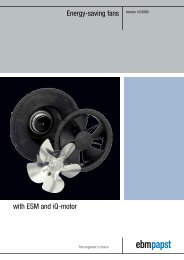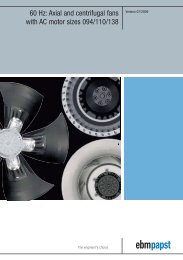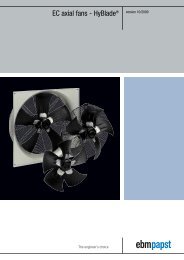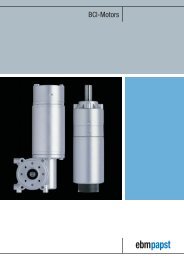Download [PDF] 2.1 MB - ebm-papst UK
Download [PDF] 2.1 MB - ebm-papst UK
Download [PDF] 2.1 MB - ebm-papst UK
Create successful ePaper yourself
Turn your PDF publications into a flip-book with our unique Google optimized e-Paper software.
FAN COIL<br />
Figure 2 (left): GreenTech EC blowers from<br />
<strong>ebm</strong>-<strong>papst</strong> in a fan coil unit from Kampmann<br />
– invisible to the guest but indispensable for<br />
the air-conditioning system.<br />
Figure 3a: The K3G146 energy-saving<br />
EC centrifugal blower from <strong>ebm</strong>-<strong>papst</strong> ensures<br />
a pleasant room temperature while remaining<br />
blissfully quiet.<br />
Figure 3b: RadiPac centrifugal fans such<br />
as the R3G355 used in the Airblock C, with<br />
aluminium-welded impeller and energy-saving<br />
EC technology have an especially space-saving<br />
construction as compared with belt-driven<br />
motors.<br />
as single, dual or triple fans with a power of between<br />
40 and 250 W, to suit the room size. In all<br />
sizes, they offer energy savings of up to 70 % and<br />
noise reduction of up to 5 dB(A). Thanks to the<br />
plug-and-play solution, existing units can also be<br />
retrofitted without a great deal of work (Figure 4).<br />
<strong>ebm</strong>-<strong>papst</strong>’s product range includes EC fans<br />
in the power range 400 W - 12 kW for ventilation<br />
and air-conditioning technology (VACT).<br />
The RadiPac range (Figure 3b) with aluminium-welded<br />
impellers and integrated control<br />
electronics enable a design that saves on space<br />
compared to models with belt-driven motors. The<br />
resulting space saving also facilitates installation<br />
and start-up. The intelligent control electronics<br />
of the GreenTech EC centrifugal fans enable<br />
a number of different automation and management<br />
tasks to be implemented via MODBUS. Major<br />
savings can be made on the electrical operating<br />
costs thanks to the ability to control the<br />
GreenTech EC centrifugal fans based on actual<br />
requirements.<br />
Benefits of a decentralised system The hotel’s<br />
owner, Robert Rentzsch, explains that “For<br />
me, the energy-efficient EC motors were a crucial<br />
determining factor, because I had designed the<br />
entire building with a view to keeping the operating<br />
costs as low as possible.”<br />
The hotel owner has installed 40 Venkons<br />
in the Abasto Hotel: 31 in the guest rooms and<br />
nine in the restaurant. Heat is provided via a heat<br />
pump with 45 °C flow temperature, and cooling<br />
is provided using ground water. The highlight<br />
of the system is that heating and cooling takes<br />
place actually inside the room itself; the ventilation<br />
unit under the roof merely provides fresh air<br />
and recovers 81 % of the heat from the air extracted<br />
from the room. Standard centralised units<br />
heat and cool the air centrally and then distribute<br />
the air around the building via air ducts. The Airblock<br />
C ventilation unit (Figure 5) manufactured<br />
by Kampmann using GreenTech EC fans now only<br />
supplies the fresh air – the decentralised Venkons<br />
inside the hotel rooms are operated individually.<br />
The unit is therefore very compact and the<br />
supply air ducts can also be made smaller. As a<br />
result, transport losses are also greatly reduced.<br />
For Robert Rentzsch, the factor of whether<br />
a system is decentralised or not is in itself no insignificant<br />
matter: “For heating installers, space<br />
is always a major issue.” This is because centralised<br />
systems necessitate ducts with large<br />
cross-sectional areas. Rentzsch has managed<br />
to install the system with just 30 centimetres of<br />
intermediate ceiling at the Abasto Hotel. With a<br />
centralised system he would have required up<br />
to 80 centimetres – dead space that would only<br />
have increased costs. “I was convinced straight<br />
away that we should be heating and cooling the<br />
air where it is actually going to be used”, says<br />
Rentzsch.<br />
The operating costs at a glance “I believe<br />
that the concept we have here is the best possible<br />
solution for hotel applications”, claims Ulrich<br />
Budde with conviction. He is also pleased about<br />
the increased level of controllability. If the air<br />
quality is OK, the system simply provides heat or<br />
cooling as required; if the temperature is OK, the<br />
system simply provides ventilation.<br />
6<br />
techmag 02°2013


![Download [PDF] 2.1 MB - ebm-papst UK](https://img.yumpu.com/36174834/6/500x640/download-pdf-21-mb-ebm-papst-uk.jpg)


![Compact fans for AC and DC [PDF] - ebm-papst](https://img.yumpu.com/48610592/1/184x260/compact-fans-for-ac-and-dc-pdf-ebm-papst.jpg?quality=85)
![Download [PDF] 9.8 MB - ebm-papst Automotive & Drives](https://img.yumpu.com/47171334/1/184x260/download-pdf-98-mb-ebm-papst-automotive-drives.jpg?quality=85)

![Download [PDF] 3.1 MB - ebm-papst UK](https://img.yumpu.com/40847594/1/185x260/download-pdf-31-mb-ebm-papst-uk.jpg?quality=85)

![Download [PDF] 2.3 MB - ebm-papst UK](https://img.yumpu.com/35271378/1/190x252/download-pdf-23-mb-ebm-papst-uk.jpg?quality=85)
![Download [PDF] - ebm-papst UK](https://img.yumpu.com/35139755/1/190x135/download-pdf-ebm-papst-uk.jpg?quality=85)

![Download [PDF] 1.5 MB - ebm-papst UK](https://img.yumpu.com/30021941/1/184x260/download-pdf-15-mb-ebm-papst-uk.jpg?quality=85)
![DC fans - specials [PDF] 1.2 MB](https://img.yumpu.com/28121898/1/184x260/dc-fans-specials-pdf-12-mb.jpg?quality=85)
